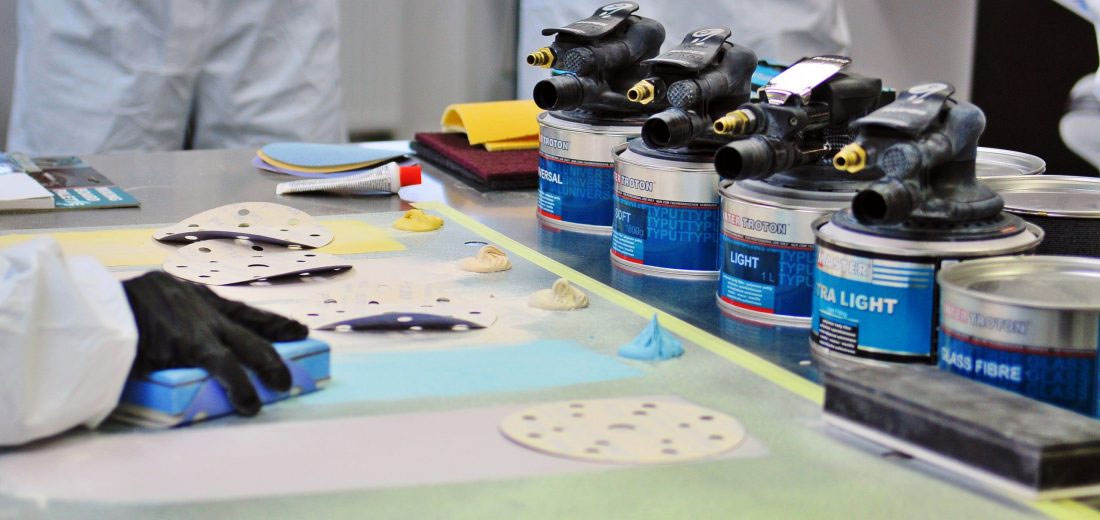Putties – hard to imagine a proper preparation of the substrate without using them

A repair of a following-accident car is a major challenge. It is a multistage process, which if properly carried out, might generate huge profits for a paint shop.
Firstly, when doing a car repair, a proper judgment of damages on car body needs to be assessed. Having done that, essential work which needs to be done can be planned out. The next step is a preparation of essential tools and selection of proper materials in correct amount. A putty is a product, which is hard to imagine without in the beginning stages of the repair. Thanks to it, a proper substrate of the bodywork can be prepared for lacquering. It can be successfully used in car repair with small and big damages. Let’s concentrate on the advantages of putties such as levelling off roughness, which might occur during sanding or welding. It is presumed that a safe layer of putty is maximum 500 µm and covers maximum 15% – 20% of the substrate. Unless a special product with corrosion inhibitors additives is used. Then we can fill even the broadest damages on bodywork.
There is a wide range of more expensive and cheaper putties available on the market, which purpose varies according to its properties. For an experienced car refinisher, it is not hard to choose the right putty. Quite often, it is chosen based on cheap price, but let’s bear in mind that it is not the most important parameter. It is obvious that with price comes quality, which will help us come up with a desirable effect. Another important factor is the type of material of an element we want to repair. Depending on this, such parameters of the product as durability, firmness, contractility, elasticity and ease of use are assorted. One type of putty might be available in two versions: filling and finishing putty. It depends on the amount of the filler such as silica bubles. When putty is softer, then it can be used for manual sanding. However, when it is harder, then it is better to use it for machine sanding. For instance, when preparing a fender made of steel, we need a different type of putty than when preparing a plastic one. Basically, when we know what type of repair we deal with, we are able to choose the best matching putty for it. Technical data sheets prepared by manufacturers will be useful, as they comprehensively inform about such characteristics as ingredients, purpose or directions for use. Pieces of information included in the data sheet have to be true. However, promotional and marketing materials focus mainly on advantages of a product, so we will not be able to find out about its durability, constraints in directions for use and purpose in these materials.
1K putty is a product occasionally used by refinishers. Its main disadvantage is that after opening it has to be quickly used, because its content dries out fast. What makes up for this is the fact that the product is ready to use straight away. It is a different matter with the 2K version, which consists of a putty and a hardener. Such product will enable us to use a specific amount, which is needed. What needs to be remembered is the right ratio of putty to hardener as well as mixing it properly. The hardness of the putty does matter, because it affects its elasticity. Harder versions will be appropriate for smaller surfaces. The bigger the surface though, the more elastic the putty needs to be making it much easier to apply and sand.
Universal putties are the most popular amongst refinishers. They have a different elasticity and they ensure a good adhesion. They can be applied on most of the substrates. They are the best choice for small and medium dents. Always remember to familiarize yourself with the Technical Data Sheet. Before use, it is a good idea to find out in the sheet whether primer also needs to be used and whether putty can be directly applied on the surface. Regardless, before applying the product, the surface needs to be degreased first. If we want to get rid of small cracking and dent, it is worth applying putty with a spray gun. It will make our work easier with every detail of dents. The putty with glass fiber is appropriate for filling extensive dents, welding and metal joints. This type of putty is available in two versions – finishing and filling. If we want to apply the product directly on steel, look for the one with corrosion inhibitors. They are irreplaceable in off-road vehicles’ repair and in those which come into contact with dampness and saltiness. The putty with aluminum is the best choice for the repair of elements exposed to overheating. Its main characteristic is good heat conduction and vibration resilience. After filling crackings and dents, such a product needs to maintain a certain elasticity.
To sum up, there is a wide range of putties available. However, a thorough reseach or experience will let us choose the most suitable product for a specific repair.